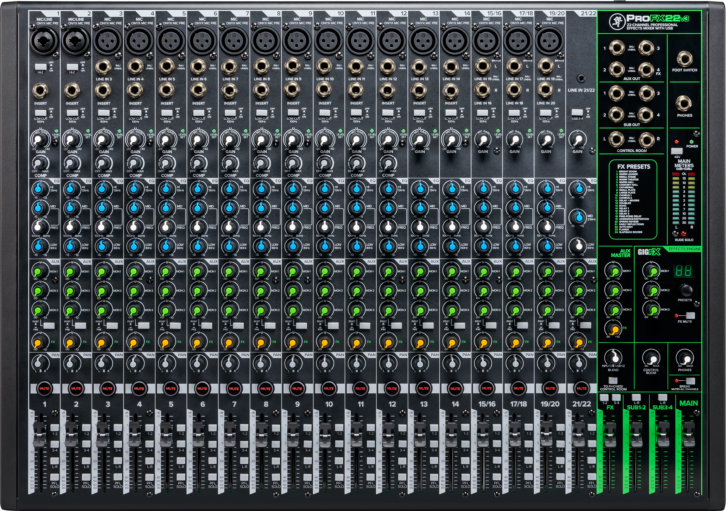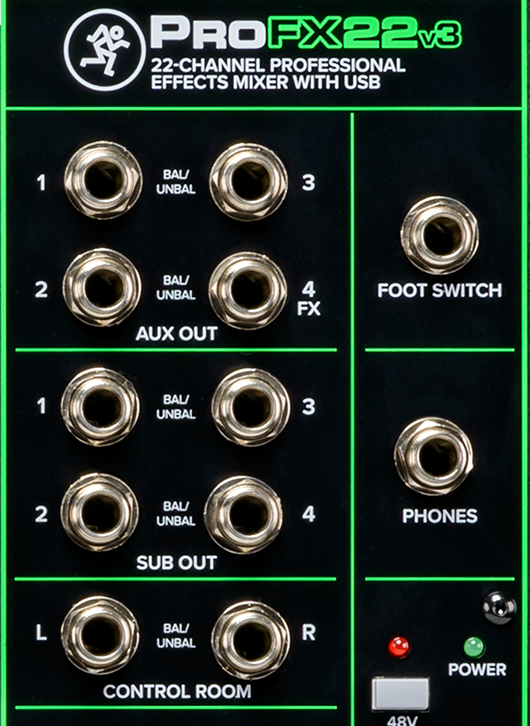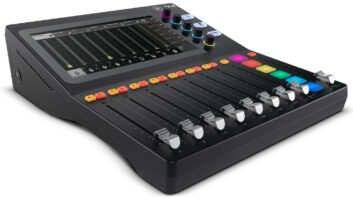
Mackie recently released version 3 of its ProFX line of mixers. The revamped series consists of six different-sized compact consoles that combine analog mixer functionality, a USB interface for recording and a digital effects engine, all at affordable price points. The mixers come in a variety of channel configurations, including 6, 10, 12, 16, 22 and 30.
This review will focus on the ProFX22v3. Note that some of the features, such as number of compressors, number of EQ bands, size of the LED meters and more, differ depending on which model of ProFXv3 you get. Mackie offers a useful comparison chart on its website.
The Basics
The ProFX22v3, like other Mackie mixers, is housed in a metal chassis and seems quite solidly built. Its 22 input channels include several different types: Channels 1 and 2 offer combo inputs and can handle mono mic, line or high-impedance sources. Channels 4–14 sport separate XLR mic inputs and mono TRS line inputs.
Channels 15–16, 17–18 and 19–20 are stereo pairs that can also function as mono mic inputs. Mackie equipped them with an XLR jack and a stereo pair of TRS line inputs. Finally, channel 21–22 is the return channel for the USB output when you’re connected to a computer. You can also patch in analog audio through its 3.5mm stereo input from a phone or other mobile device.
The channel faders are of the “short-throw” variety (roughly 60 mm) and feature assign buttons for the L/R output and two Subgroup outputs, 1/2 and 3/4, along with a PFL (pre-fader listen) button. The latter allows the engineer to put the unit into solo so that the output is only heard through the control room or headphone outputs. Each channel also sports a Mute button.
One of the big improvements in version 3 of the ProFX line is that all the preamps are now Onyx, which are Mackie’s best. Particularly since the ProFXv3 mixers are being touted for studio as well as live use, the Onyx preamps, which offer clean and accurate reproduction, are a valuable addition.
The ProFX22v3’s phantom power is globally switched. Although I don’t expect a mixer in this price range would have individual phantom switches, grouping them on more than one switch would have been useful. There are some occasions when you don’t want phantom power (such as when connecting older ribbon mics). That said, it probably won’t be an issue for most users.

Signal Processing
Despite their differences, all the channels have certain common features, one of which is a 3-band EQ. The upper and lower bands are fixed shelving filters set at 80 Hz and 12 kHz, respectively. The midrange band is a bell-shaped filter with both a frequency knob and one for boosting and cutting. Particularly for live use, it gives you plenty to work with. Each channel also offers a low-cut filter that rolls off at 100 Hz with an 18 dB/octave slope.
Another common feature is a Gain knob and a “level set” LED. The latter flash green to indicate you have sufficient level and stay on when the input is being overloaded. To me, it would be preferable if they turned red to indicate overload. It would be easier to discern at a glance. I really like the Main Meters, which feature 12-step ladder style LEDs and are easy to see and read.
Channels 1–12 each include a one-knob compressor. It’s fixed at a 6:1 ratio with a soft knee, and the knob controls the threshold. I imagine they will be particularly valuable when used in live performance for controlling the dynamic range of sources like vocals and drums. The compressors are less critical for recording—where you can apply dynamics plug-ins in the mix that offer a lot more control—unless you want to compress on input.
Each channel also features three aux sends, labeled Monitor 1, 2 and 3. Monitor 1 and 2 are pre-fader and Monitor 3 is switchable between pre and post. Each of the mono channels (1–14) is equipped with an unbalanced 1/4-inch TRS Insert jack that’s designed to take a standard 1/4-inch TRS insert cable.
In addition to allowing you to insert external devices on specific channels, you can plug a mono 1/4-inch cable in part way and use it as a direct out. When you do, the signal flow for the channel doesn’t get interrupted. If you push the jack all the way into the insert, it functions as a direct out that does interrupt the internal mixer signal.
Either direct out option gives you a signal that’s pre-fader, so it’s not impacted by any of the channel controls except for the Gain knob. With the jacks only partially in, you could, for example, feed a DAW or other multitrack with unmixed, unprocessed audio. Of course, a mixer with 14 partially plugged in jacks might not be the most durable setup in a club or other live venue.
Each channel also has an FX send knob for the internal effects processor. The knobs send an identical signal to any external effects processor connected to the FX output jack.
The back panel of the mixer is home to the master output pair, which is duplicated on both XLR and 1/4-inch TRS jacks. It’s also where you find the USB 2.0 jack and the IEC electrical jack. The rest of the outputs are located in the master section on the right of the mixer’s face.
All of these are 1/4-inch and support balanced or unbalanced cables. They include Control Room outputs for feeding studio monitors or headphone amps, three individual mono Aux output jacks and the FX output. Other front-panel jacks include a TRS stereo headphone output and the Foot Switch jack. Connect a standard footswitch to it, and you can mute and unmute the effects section, hands free.
Start the Engine
The effects engine has been souped up for the v3 mixer line. Dubbed GigFX, it lets you choose from 24 effects presets. These include many different reverbs, two chorus effects, a flanger, a doubler, a number of different delays, a couple of hybrid delay/reverb effects and even an auto/wah. Each channel has its own FX send, and each monitor mix has its own master effects send, which is handy.
The built-in GigFX engine is excellent. The reverbs are clean and shimmery, and the effects overall are of high quality. The effects section is limited by two factors: You can only have one effect on at a time, and you get virtually no parameter control. I realize that this setup is customary for compact mixers, but I would rather have fewer effects and more control. Particularly if I were a live engineer, I’d gladly trade the choruses and flangers and auto/wahs—how often are you going to use those live?— for an engine with only reverb and delay, and the ability to adjust room size, delay time and feedback.
The FX jack shares the same effects send circuit as the internal effects. Whatever signal you send to the internal effects appears in equal strength to the FX jack. It’s not the most flexible design, but it is useful to be able to patch in external processing. Being able to connect up, say, a dedicated delay unit, would help mitigate the absence of parameter control for the internal effects. However, the FX circuit has no dedicated return, so you’d have to use one or two of the input channels for that.
USB for You and Me
One of the many benefits you get from this mixer is its ability to function as a USB audio interface. That means not only can you record a live stereo mix into a laptop (or an iOS device with an Apple Camera adapter) at the gig, you can also bring it home from the gig and set it up in your studio as your interface.
It’s USB 2.0 class-compliant for Mac and requires drivers—available for download on the Mackie site—for Windows. The USB implementation is limited from a channel standpoint. You can only record two channels in and monitor two channels out. The interface is listed as being 2×4 in the specs, and you do see both outputs 1–2 and 3–4 showing up in your DAW once connected.
However, it’s effectively a 2×2 interface because you can only monitor one of the output pairs in the mixer at any given time. A switch on channels 21/22 lets you toggle between which output pair you’re hearing. The manual, which is mainly pretty useful (and, like other Mackie manuals, has a pleasant, breezy style) is vague about the output situation.
Having only two inputs for recording means you can’t take advantage of all those Onyx preamps to record a band or ensemble except as a live stereo mix. The only way to configure a multitrack session of more than two tracks would be to plug your miked and DI’d sources into the preamps and use the direct outs to go into another audio interface that has more line inputs.
That said, if you typically only record one or two tracks of audio at a time, then you’ll be quite happy with the functionality of the ProFX22v3. What’s more, you can record through the effects if you want, and you can use the EQ and compressor on input. Those are capabilities not found on most audio interfaces.
You can monitor with zero latency by adjusting the Blend knob, which lets you change the proportion of direct audio and audio returning from your DAW via USB.
Bundle of Joy
The bundled software that comes with the ProFXv3 mixers is extensive and gives you quite a bit of value. You get Tracktion Waveform 8 OEM, which is a reduced-feature—but still fairly robust—version of the Waveform DAW (formerly known as Tracktion).
You also get the DAW Essentials Collection, which provides 16 different studio effects plug-ins from Tracktion, including a reverb, several delays, a compressor, a bus compressor, EQ and more.
You also get an Avid plug-in bundle that you can use with the free Pro Tools First (or other versions of Pro Tools). The bundle comes with 22 plug-ins, including the 304E equalizer and 304C compressor. Avid normally sells the 304E and 304C together for $299.
There’s plenty to like about the ProFX22v3, which also applies to the other models in the series, particularly the 16- and 30-channel versions, which have the fullest feature sets. As a live mixing console, it’s got a lot going for it, including excellent-sounding Onyx preamps, plentiful I/O, three independent monitor sends, solid EQ, individual channel compressors and a great-sounding, built-in effects processor.
The ability to double as an audio interface makes live stereo recording easy and gives you the option of recording to another multitrack using the direct outputs.
For studio use, if you don’t need to be able to record more than two tracks simultaneously, it offers a lot of intriguing features, despite its small I/O count.
Product Summary
COMPANY: Mackie
PRODUCT: ProFX22v3
WEBSITE: Mackie.com
PRICE: $699
PROS: Onyx preamps offer solid sound quality; well-designed for live mixing; powerful built-in effects engine; three monitor sends; external FX send; functions as USB interface; solid build quality; compressors on all mono input channels; extensive software bundle; footswitch Jack turns on and off the internal effects; good value
CONS: Limited I/O on USB interface; phantom power globally switched; no parameter control on built-in effects; internal FX and external FX send share same sends







